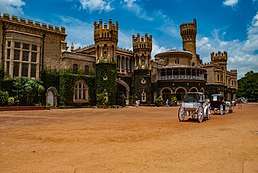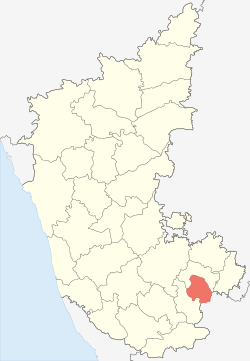Bangalore Urban district
Bangalore Urban district, officially known as, Bengaluru Urban district, is a district of the Indian state of Karnataka. It is surrounded by the Bangalore Rural district on the east and north, the Ramanagara district on the west and the Krishnagiri district of Tamil Nadu on the south. Bangalore Urban district came into being in 1986, with the partition of the erstwhile Bangalore into Bangalore Urban and Bangalore Rural districts. Bangalore Urban has five taluks: Bangalore North (Bengaluru), Bangalore South (Kengeri), Bangalore East (Krishnaraja Pura), Yelahanka and Anekal. The city of Bangalore is situated in the Bangalore Urban district. The district has 17 hoblies, 668 villages and 9 municipal corporations. There are five talukas; Electronics City is situated in Anekal Taluka.
Bangalore Urban district | |
|---|---|
District | |
| Bengaluru city district | |
 The Bangalore Palace | |
 Location in Karnataka | |
| Coordinates: 12.970214°N 77.56029°E | |
| Country | |
| State | Karnataka |
| Headquarters | Bangalore |
| Talukas | Bangalore, Kengeri, Krishnaraja Pura, Yelahanka, Anekal |
| Government | |
| • Deputy Commissioner | K.Srinivas, I.A.S |
| Area | |
| • Total | 2,196 km2 (848 sq mi) |
| Population (2011)[1] | |
| • Total | 9,621,551 |
| • Rank | 3rd (India) |
| • Density | 4,400/km2 (11,000/sq mi) |
| Languages | |
| • Official | Kannada |
| • Spoken | Kannada and English |
| Time zone | UTC+5:30 (IST) |
| Vehicle registration |
|
The district had a population of 6,537,124 of which 88.11% is urban as of 2001.[2] As of Census 2011, its population has increased to 9,621,551, with a sex-ratio of 908 females/males, the lowest in the state and its density is 4,378 people per square km.[3]
Geography
Climate
The climate here is moderate. The lowest average temperature is about 16–18 °C (61–64 °F).
| Climate data for Bangalore | |||||||||||||
|---|---|---|---|---|---|---|---|---|---|---|---|---|---|
| Month | Jan | Feb | Mar | Apr | May | Jun | Jul | Aug | Sep | Oct | Nov | Dec | Year |
| Average high °C (°F) | 27 (81) |
29.6 (85.3) |
32.4 (90.3) |
33.6 (92.5) |
32.7 (90.9) |
29.2 (84.6) |
27.5 (81.5) |
27.4 (81.3) |
28 (82) |
27.7 (81.9) |
26.6 (79.9) |
25.9 (78.6) |
29 (84) |
| Average low °C (°F) | 15.1 (59.2) |
16.6 (61.9) |
19.2 (66.6) |
21.5 (70.7) |
21.2 (70.2) |
19.9 (67.8) |
19.5 (67.1) |
19.4 (66.9) |
19.3 (66.7) |
19.1 (66.4) |
17.2 (63.0) |
15.6 (60.1) |
18.6 (65.5) |
| Average rainfall mm (inches) | 2.7 (0.11) |
7.2 (0.28) |
4.4 (0.17) |
46.3 (1.82) |
119.6 (4.71) |
80.6 (3.17) |
110.2 (4.34) |
137 (5.4) |
194.8 (7.67) |
180.4 (7.10) |
64.5 (2.54) |
22.1 (0.87) |
969.8 (38.18) |
| Average rainy days | 0.2 | 0.5 | 0.4 | 3 | 7 | 6.4 | 8.3 | 10 | 9.3 | 9 | 4 | 1.7 | 59.8 |
| Mean monthly sunshine hours | 263.5 | 248.6 | 272.8 | 258 | 241.8 | 138 | 111.6 | 114.7 | 144 | 173.6 | 189 | 210.8 | 2,366.4 |
| Source 1: WMO[4] | |||||||||||||
| Source 2: HKO (sun only, 1971–1990)[5] | |||||||||||||
Demographics
| Year | Pop. | ±% p.a. |
|---|---|---|
| 1901 | 394,794 | — |
| 1911 | 428,228 | +0.82% |
| 1921 | 480,675 | +1.16% |
| 1931 | 590,218 | +2.07% |
| 1941 | 738,393 | +2.27% |
| 1951 | 1,253,542 | +5.44% |
| 1961 | 1,499,333 | +1.81% |
| 1971 | 2,197,347 | +3.90% |
| 1981 | 3,495,566 | +4.75% |
| 1991 | 4,839,162 | +3.31% |
| 2001 | 6,537,124 | +3.05% |
| 2011 | 9,621,551 | +3.94% |
| source:[6] | ||
According to the 2011 census Bangalore Urban district has a population of 9,621,551,[7] roughly equal to the nation of Belarus.[8] This gives it a ranking of 3rd in India (out of a total of 640).[7] The district has a population density of 4,378 inhabitants per square kilometre (11,340/sq mi) .[7] Its population growth rate over the decade 2001-2011 was 46.68%.[7] Bangalore has a sex ratio of 908 females for every 1000 males,[7] and a literacy rate of 88.48%.[7]
Temples
- Gavi Gangadhareshwara Temple
- Dodda Basavana Gudi
- Halasuru Someshwara Temple, Bangalore
- ISKCON Temple Bangalore
- Kote Venkataramana Temple, Bangalore
- Banashankari Amma Temple
- Rajarajeshwari Temple, Shanmukha Temple, Nimishamba Temple - in the vicinity of D.I.E.T.
See also
- Ajjanahalli, Bangalore South
- Bangalore Division
References
- Bangalore (Bengaluru) District Population Census 2011, Karnataka literacy sex ratio and density
- Census GIS India Archived 24 May 2012 at Archive.today
- "Girls are still scarce in IT City". The Times of India. 6 April 2011.
- "Bengaluru". World Meteorological Organisation. Archived from the original on 6 April 2010. Retrieved 21 March 2010.
- "Climatological Information for Bengaluru, India". Hong Kong Observatory. Archived from the original on 18 January 2012. Retrieved 4 May 2011.
- Decadal Variation In Population Since 1901
- "District Census 2011". Census2011.co.in. 2011. Retrieved 30 September 2011.
- US Directorate of Intelligence. "Country Comparison:Population". Retrieved 1 October 2011.
Belarus 9,577,552 July 2011 est.
External links
| Wikimedia Commons has media related to Bangalore district. |